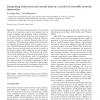Free Online Productivity Tools
i2Speak
i2Symbol
i2OCR
iTex2Img
iWeb2Print
iWeb2Shot
i2Type
iPdf2Split
iPdf2Merge
i2Bopomofo
i2Arabic
i2Style
i2Image
i2PDF
iLatex2Rtf
Sci2ools
BC
2005
2005
Integrating behavioral and neural data in a model of zebrafish network interaction
The spinal neural networks of larval zebrafish (Danio rerio) generate a variety of movements such as escape, struggling, and swimming. Various mechanisms at the neural and network levels have been proposed to account for switches between these behaviors. However, there are currently no detailed demonstrations of such mechanisms. This makes determining which mechanisms are plausible extremely difficult. In this paper, we propose a detailed biologically plausible model of the interactions between the swimming and escape networks in the larval zebrafish, while taking into account anatomical and physiological evidence. We show that the results of our neural model generate the expected behavior when used to control a hydrodynamic model of carangiform locomotion. As a result, the model presented here is a clear demonstration of a plausible mechanism by which these distinct behaviors can be controlled. Interestingly, the networks are anatomically overlapping, despite clear differences in beha...
| Added | 15 Dec 2010 |
| Updated | 15 Dec 2010 |
| Type | Journal |
| Year | 2005 |
| Where | BC |
| Authors | P. Dwight Kuo, Chris Eliasmith |
Comments (0)

